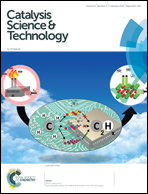Z-Scheme in a Co3(PO4)2/α-Fe2O3 photocatalysis system for overall water splitting under visible light†
Abstract
Overall water splitting under solar irradiation with a semiconductor has long been investigated as an attractive pathway to convert solar energy into chemical energy in the form of H2. However, using only a single semiconductor as a photocatalyst remains a great challenge. Designing Z-scheme systems is the most common method used for photocatalysis. We report a Z-scheme Co3(PO4)2/α-Fe2O3 structure as an efficient photocatalyst for overall water splitting under visible light. The as-prepared Co3(PO4)2/α-Fe2O3 photocatalyst shows excellent improvement in visible light absorption and photocatalytic efficiency for overall water splitting, in which Co3(PO4)2 and Fe2O3 act as H2-evolving and O2-evolving photocatalysts, respectively. By varying the amount of α-Fe2O3 in the photocatalysts, we found that Co3(PO4)2/α-Fe2O3-1.6% exhibited the optimal photocatalytic activity in hydrogen production (0.63 μmol h−1) and oxygen evolution (0.32 μmol h−1), which is almost 35-fold higher than that of a pure Co3(PO4)2 catalyst. In addition, the chemical stoichiometric ratio of H2 and O2 in the photocatalysis process is almost 2 : 1. The enhanced photocatalytic activity was attributed to the synergetic effects of Co3(PO4)2 and α-Fe2O3 in the Z-scheme structure, which resulted in highly efficient separation of photogenerated charge carriers.



 Please wait while we load your content...
Please wait while we load your content...